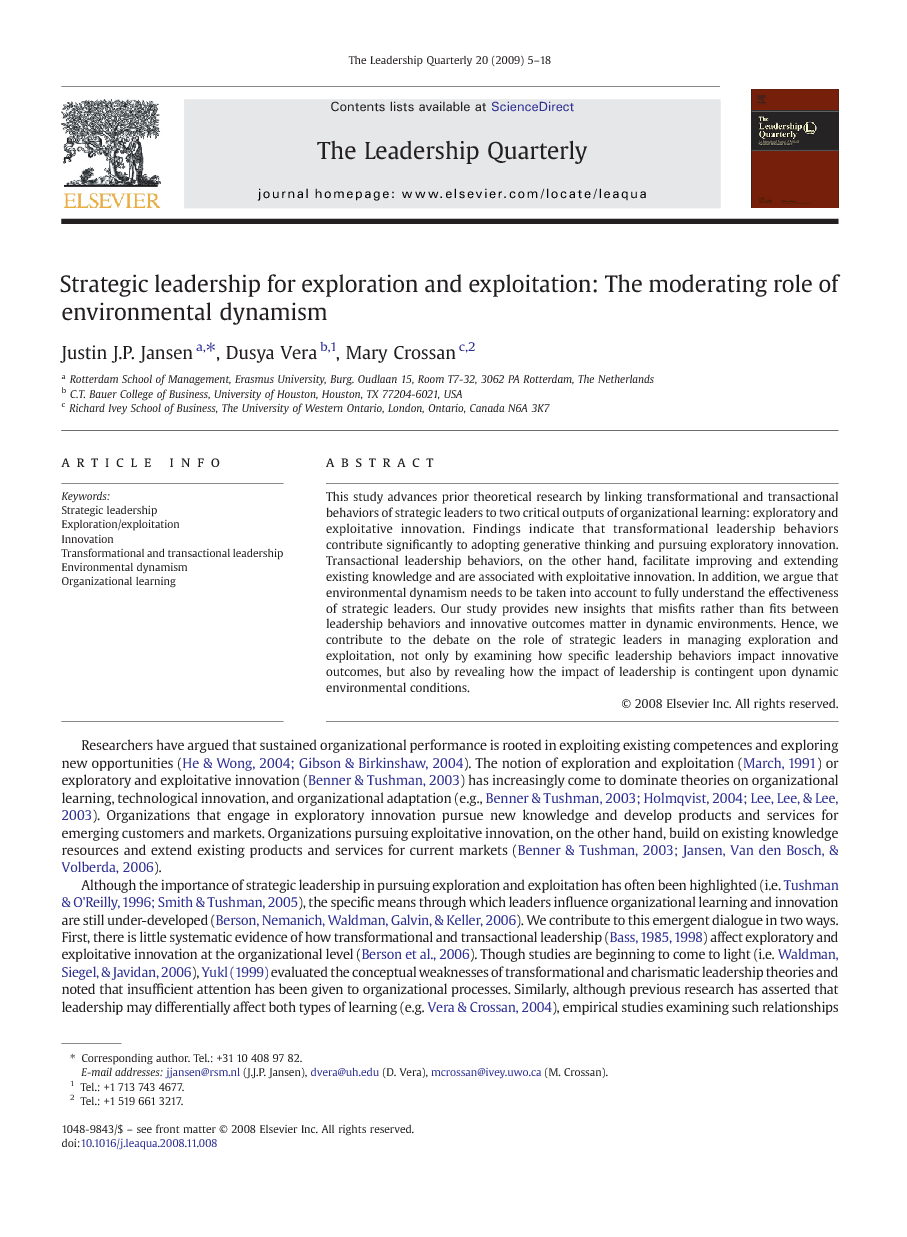This study advances prior theoretical research by linking transformational and transactional behaviors of strategic leaders to two critical outputs of organizational learning: exploratory and exploitative innovation. Findings indicate that transformational leadership behaviors contribute significantly to adopting generative thinking and pursuing exploratory innovation. Transactional leadership behaviors, on the other hand, facilitate improving and extending existing knowledge and are associated with exploitative innovation. In addition, we argue that environmental dynamism needs to be taken into account to fully understand the effectiveness of strategic leaders. Our study provides new insights that misfits rather than fits between leadership behaviors and innovative outcomes matter in dynamic environments. Hence, we contribute to the debate on the role of strategic leaders in managing exploration and exploitation, not only by examining how specific leadership behaviors impact innovative outcomes, but also by revealing how the impact of leadership is contingent upon dynamic environmental conditions.
Researchers have argued that sustained organizational performance is rooted in exploiting existing competences and exploring new opportunities (He and Wong, 2004 and Gibson and Birkinshaw, 2004). The notion of exploration and exploitation (March, 1991) or exploratory and exploitative innovation (Benner & Tushman, 2003) has increasingly come to dominate theories on organizational learning, technological innovation, and organizational adaptation (e.g., Benner and Tushman, 2003, Holmqvist, 2004 and Lee et al., 2003). Organizations that engage in exploratory innovation pursue new knowledge and develop products and services for emerging customers and markets. Organizations pursuing exploitative innovation, on the other hand, build on existing knowledge resources and extend existing products and services for current markets (Benner and Tushman, 2003 and Jansen et al., 2006).
Although the importance of strategic leadership in pursuing exploration and exploitation has often been highlighted (i.e. Tushman and O'Reilly, 1996 and Smith and Tushman, 2005), the specific means through which leaders influence organizational learning and innovation are still under-developed (Berson, Nemanich, Waldman, Galvin, & Keller, 2006). We contribute to this emergent dialogue in two ways. First, there is little systematic evidence of how transformational and transactional leadership (Bass, 1985 and Bass, 1998) affect exploratory and exploitative innovation at the organizational level (Berson et al., 2006). Though studies are beginning to come to light (i.e. Waldman, Siegel, & Javidan, 2006), Yukl (1999) evaluated the conceptual weaknesses of transformational and charismatic leadership theories and noted that insufficient attention has been given to organizational processes. Similarly, although previous research has asserted that leadership may differentially affect both types of learning (e.g. Vera & Crossan, 2004), empirical studies examining such relationships are sparse. While some evidence exists at the individual- and team-level of analysis (e.g. Pirola-Merlo, Härtel, Mann, & Hirst, 2002), the impact of strategic leadership on organizational learning and innovation is still unclear (Hambrick and Mason, 1984). Moreover, prior research has tended to focus on the more creative processes of exploration and radical innovation, thereby ignoring exploitation and incremental innovation and underestimating the organizational challenge of replicating and refining learning, and making existing knowledge sources accessible and applicable (Berson et al., 2006 and Hannah and Lester, 2009-this issue). By addressing these gaps, this study provides new theoretical and empirical insights linking strategic leadership to exploratory and exploitative innovation at the firm level.
Second, we consider the potential moderating effect of environmental dynamism on the effectiveness of leadership behaviors in relation to organizational learning and innovation. Ensley, Pearce, & Hmieleski (2006) found that the effectiveness of transformational and transactional behaviors on new venture performance varies with levels of environmental dynamism. In addition, Waldman, Ramirez, House, & Puraman (2001) showed how the impact of transactional and charismatic leadership on firm performance is contingent upon perceived environmental uncertainty and volatility. Less well documented is the contingency perspective we propose, which underscores the effectiveness of transformational and transactional leadership to pursuing exploratory and exploitative innovation under different contextual conditions.
Drawing from theories of leadership, organizational learning and innovation, this study finds that different leadership behaviors are necessary to support exploratory and exploitative innovation and that misfits rather than fits between leadership style and innovative outcomes matter in dynamic environments. Through this richer explanation and empirical assessment, we contribute to greater clarity of how strategic leaders may contribute to successfully developing exploratory and exploitative innovation. In the next section, we present the literature review and hypotheses. After describing our research method, we present the empirical findings using data from 305 senior team members and 89 executive directors at autonomous branches of a financial services firm. We conclude with a discussion of the results, implications, and issues for future research.


